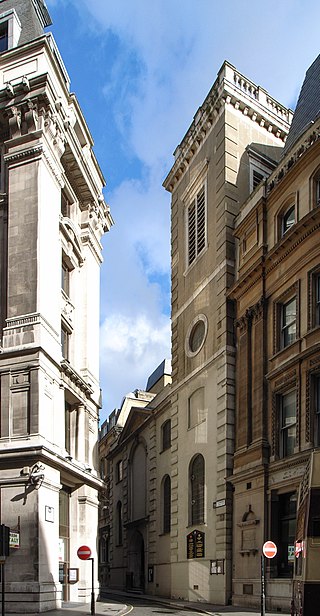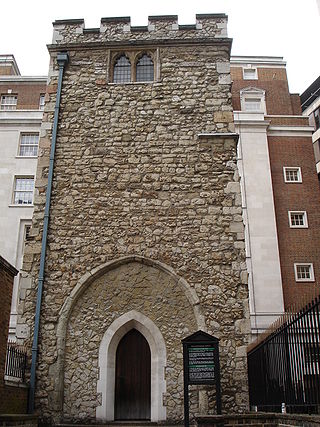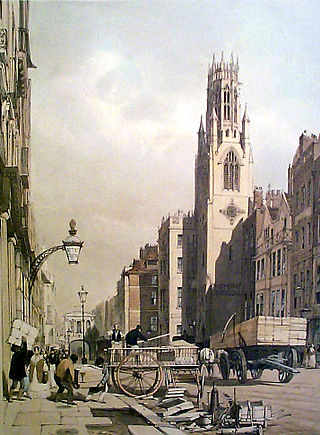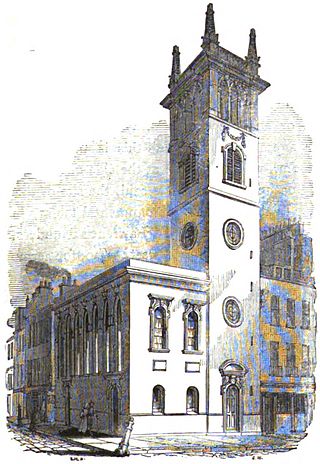
St Bride's Church is a Church of England church in Fleet Street in the City of London. Likely dedicated to Saint Bridget perhaps as early as the 6th century, the building's most recent incarnation was designed by Sir Christopher Wren in 1672, though Wren's original building was largely gutted by fire during the London Blitz in 1940 and then was faithfully reconstructed in the 1950s.

St Clement Eastcheap is a Church of England parish church in Candlewick Ward of the City of London. It is located on Clement's Lane, off King William Street and close to London Bridge and the River Thames.

All Hallows-by-the-Tower, at one time dedicated jointly to All Hallows and the Virgin Mary and sometimes known as All Hallows Barking, is an ancient Anglican church on Byward Street in the City of London, England, overlooking the Tower of London.

St Andrew Undershaft is a Church of England church in the City of London, the historic nucleus and modern financial centre of London. It is located on St Mary Axe, within the Aldgate ward, and is a rare example of a City church that survived both the Great Fire of London and the Blitz.

The Church of St Margaret, Westminster Abbey is in the grounds of Westminster Abbey on Parliament Square, London, England. It is dedicated to Margaret of Antioch, and forms part of a single World Heritage Site with the Palace of Westminster and Westminster Abbey.

Holy Sepulchre London, formerly and in some official uses Saint Sepulchre-without-Newgate, is the largest Anglican parish church in the City of London. It stands on the north side of Holborn Viaduct across a crossroads from the Old Bailey, and its parish takes in Smithfield Market. During medieval times, the site lay outside ("without") the city wall, west of the Newgate.

The Guild Church of St Katharine Cree is an Anglican church in the Aldgate ward of the City of London, on the north side of Leadenhall Street near Leadenhall Market. It was founded in 1280. The present building dates from 1628 to 1630. Formerly a parish church, it is now a guild church.

All Hallows Staining was a Church of England church located at the junction of Mark Lane and Dunster Court in the north-eastern corner of Langbourn ward in the City of London, England, close to Fenchurch Street railway station. All that remains of the church is the tower, built around AD 1320 as part of the second church on the site. Use of the grounds around the church is the subject of the Allhallows Staining Church Act 2010.

St Giles-without-Cripplegate is an Anglican church in the City of London, located on Fore Street within the modern Barbican complex. When built it stood without the city wall, near the Cripplegate. The church is dedicated to St Giles, patron saint of handicapped and infirm people of many different kinds. It is one of the few medieval churches left in the City of London, having survived the Great Fire of 1666.

The Guild Church of St Dunstan-in-the-West is in Fleet Street in the City of London. It is dedicated to Dunstan, Bishop of London and Archbishop of Canterbury. The church is of medieval origin, although the present building, with an octagonal nave, was constructed in the 1830s to the designs of John Shaw.

All Hallows Bread Street was a parish church in the Bread Street ward of the City of London, England. It stood on the east side of Bread Street, on the corner with Watling Street. First mentioned in the 13th century, the church was destroyed in the Great Fire of London in 1666. The church was rebuilt by the office of Sir Christopher Wren and demolished in 1876.

All-Hallows-the-Great was a church in the City of London, located on what is now Upper Thames Street, first mentioned in 1235. Destroyed in the Great Fire of London of 1666, the church was rebuilt by the office of Sir Christopher Wren. All-Hallows-the-Great was demolished in 1894 when many bodies were disinterred from the churchyard and reburied at Brookwood Cemetery.

St Olave's Church, Old Jewry, sometimes known as Upwell Old Jewry, was a church in the City of London located between the street called Old Jewry and Ironmonger Lane. Destroyed in the Great Fire of London in 1666, the church was rebuilt by the office of Sir Christopher Wren. The church was demolished in 1887, except for the tower and west wall, which remain today.

St Martin, Ludgate, also known as St Martin within Ludgate, is an Anglican church on Ludgate Hill in the ward of Farringdon, in the City of London. The church is of medieval origin, but the present building dates from 1677 to 1684 and was designed by Sir Christopher Wren.

St Benet Gracechurch, so called because a haymarket existed nearby (Cobb), was a parish church in the City of London. First recorded in the 11th century, it was destroyed in the Great Fire of London of 1666 and rebuilt by the office of Sir Christopher Wren. The church was demolished in 1868.

The Worshipful Company of Parish Clerks is one of the Guilds of the City of London. It has no livery, because "in the 16th century, the Parish Clerks declined to take the Livery on the grounds that the surplice was older than the Livery and was the proper garb of members of the Company." It is not, therefore, technically a livery company although to all intents and purposes it acts as such. It is one of two such historic companies without livery, the other being the Company of Watermen and Lightermen.

St Katherine Coleman was a parish church in the City of London, situated in St Katherine's Row, on the south side of Fenchurch Street, in Aldgate Ward. Of medieval origin, it narrowly escaped destruction in the Great Fire of London in 1666, but was rebuilt in the eighteenth century. The church closed in November 1926 and was demolished soon afterwards.

Tower is one of the 25 wards of the City of London and takes its name from its proximity to the Tower of London. The ward covers the area of the City that is closest to the Tower.

Mark Lane is a street in the City of London linking Great Tower Street and Fenchurch Street. It gave its name to the nearby Mark Lane tube station, which was opened in 1884, renamed Tower Hill in 1964, and closed three years later. For some 240 years, Mark Lane was known for the corn exchange ; it occupied a series of properties on the east side of the southern end of the street.

Seething Lane is a street in the City of London. It connects All Hallows-by-the-Tower, Byward Street, with St Olave's Church, Hart Street. The street is named after an Old English expression meaning "full of chaff", which was derived from the nearby corn market in Fenchurch Street. Samuel Pepys lived there and is buried in St Olave's Church at the junction with Hart Street. A bust of Pepys, created by Karin Jonzen, sits in the public garden at the south end of the street.


























